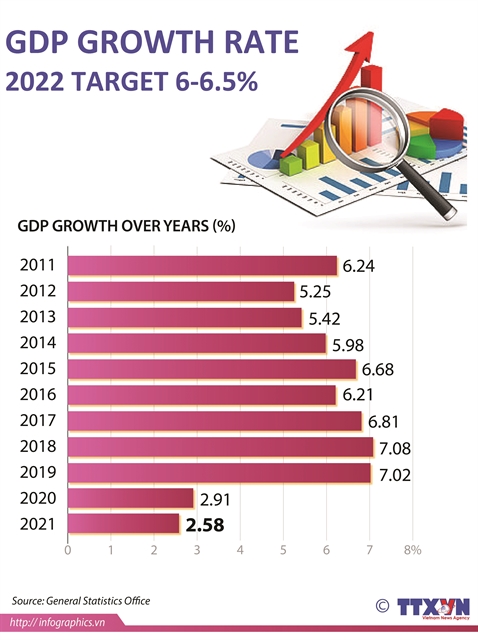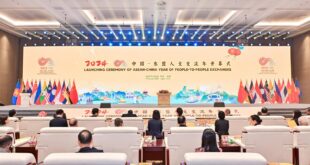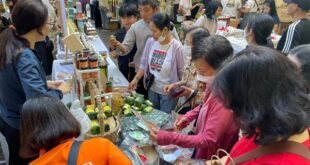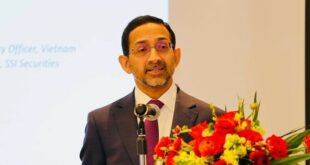
By Ngọc Bích
It’s been two years since the world economy first suffered the devastating impact of the COVID-19 pandemic – one of the most unprecedented events since World War II. As an open economy, Việt Nam could not be spared the global health crisis.
Social distancing measures to prevent the spread of the coronavirus worldwide have forced millions of household businesses to temporarily or permanently be closed, while the operation of thousands of enterprises is suspended. This has made millions of families lose income.
Notably, what happened to the Vietnamese economy over the past two years seemed to be contrary to the rest of the world.
In 2020, while the vast majority of countries in the world recorded negative growth, Việt Nam was a rare country that managed to maintain positive GDP growth with an increase of 2.91 per cent.
In 2021, while the economies around the world had been on track to recover thanks to the boosted vaccination rollout, the Vietnamese economy was more heavily affected by the pandemic with the new Delta variant.
In the third quarter of 2021, Việt Nam recorded its first-ever negative quarterly GDP. For the whole year of 2021, the economy expanded 2.58 per cent, missing the year’s GDP growth target of 6.5 per cent, nearly half the GDP growth rate of the whole world (5.9 per cent).
This year, once again the Government has set a target of 6-6.5 per cent GDP growth rate, equivalent to the pre-pandemic average level. Whether it is reachable or not is hard to say as long as the pandemic is not under control. However, many experts and institutions are optimistic about the country’s strong economic recovery this year.
Standard Chartered Bank forecasts Việt Nam’s recovery to accelerate markedly in 2022, with GDP growing by 6.7 per cent. In the recent “Vietnam at a Glance” report, HSBC said after two years of growth slowdown, the country’s economic growth will regain momentum to reach 6.5 per cent in 2022. Though being more cautious, the World Bank expects the economy to rebound with GDP rising by 5.5 per cent.
Foundations for optimism
According to experts, the Vietnamese economy has the foundations to bounce back.
First of all, the Government has switched from ‘No COVID’ to a ‘living with the pandemic’ strategy, with Resolution 128/NQ-CP on safe and flexible adaption to and effective control of the COVID-19 pandemic, said Dr Võ Trí Thành, an economist, former vice-director of the Central Institute for Economic Management (CIEM).
Issued in early October last year, Resolution 128 was a “game-changer” in the way Việt Nam fights COVID-19 and revitalises the economy. Because of the resolution, GDP growth bounced back to 5.22 per cent in the final quarter of 2021 after shrinking over 6 per cent in the previous quarter – a consequence of the ‘No COVID’ approach that left the country grappling with lengthy shutdowns in major economic centres.
“Over the past two years, we have become more aware of and been better prepared to respond to the pandemic with improved healthcare capacity, wider vaccine coverage, and more efficient treatment drugs,” Thành said.
Secondly, the Vietnamese economy has welcomed the good news that the National Assembly approved a socio-economic recovery programme, proposed by the Government, worth nearly VNĐ350 trillion (approximately US$15 billion). This is “a strong message to the market”, according to Thành.
Lasting for two years from 2022 to 2023, the package has been assessed “as large enough in terms of the funds, long enough in terms of the implementation period and wide enough in terms of the scope of its coverage”, said Thành.
Looking outside, Dr Phạm Sỹ An, an economist, at the Việt Nam Academy of Social Sciences, said the world economy was also recovering after a period of sluggishness, so “our economy will be able to take advantage of the recovery through trade and investment attraction”.
The Regional Comprehensive Economic Partnership (RCEP) – the world’s largest free trade agreement – came into effect in January this year. Being a signatory to the pact would bring Việt Nam opportunities of accessing larger consumption markets with lower barriers, An said, adding the Vietnamese economy would become more attractive to foreign investors.
Luke Hong, group head and lead economist for Việt Nam at the ASEAN+3 Macroeconomic Research Office, said that Việt Nam was well-placed to benefit from lower tariffs brought by free trade agreements.
“The country stands to gain the most from trade, particularly exports of manufactured goods and agricultural products,” Hong said.
According to him, the key drivers of growth for this year will be the manufacturing and service sectors.
FDI was expected to remain strong in 2022, Hong said, adding that it had partly contributed to the country’s economic growth as manufacturing capacity was being expanded to take advantage of the rebound in external demand as well as emerging trends of investment in digitalisation.
Challenges and recommendations
However, opportunities always go hand in hand with challenges.
Though Việt Nam’s pace of vaccination is among the fastest in the world and there are some suggestions that the contagious Omicron variant signals the end of the pandemic, its developments are still complicated and unpredictable.
“We do not know for sure whether the pandemic will end though it is likely,” Dr An said.
Former CIEM vice-director Thành agreed, saying: “We cannot rule out the possibility of another resurgence caused by a new transmissible variant. ‘Living safely with the pandemic’ does not mean there is no risk at all.”
Despite strong determination to revitalise their economies, governments of countries worldwide, especially developed ones, are more cautious with their economic stimulus packages amid inflation pressure.
“Many countries have more or less considered and adjusted monetary policy (which is very loose), economic support packages (which are very large) in the direction of gradually tightening. This makes the recovery process more arduous, especially for developing and emerging countries,” Thành said.
“Việt Nam should be more prudent when taking loose fiscal and monetary measures as stated in the economic recovery supporting programme as they will probably cause side-effects such as an increase in inflation, budget deficit and public debt.”
Dr An also warned of the hike in banking bad debts and the flow of money in real estate and securities markets, rather than production.
An said that it was necessary to implement the programme drastically and in time, and the funds be disbursed to the right beneficiaries as soon as possible.
“To do so, the disbursement procedures must be simplified but transparency must be ensured to avoid serving vested interests. The scale of the programme is not a decisive factor in its success. It rather depends on the way it is designed and carried out,” An said.
Dr Thành said: “The implementation of support packages launched since the beginning of 2020 shows that obtaining financial resources is difficult, but getting them to the people in need of support on time is even more difficult.
“Policy design, policy coordination, policy implementation and monitoring are aspects that need to be fully taken into account to ensure the support package is effective.”
Dr An said: “Joining free trade agreements has presented Việt Nam not only with opportunities but also challenges, as the competitive pressure for businesses and employees is also heavier.
“Competitive pressure will force enterprises to innovate technology and change production organisation to improve productivity and competitiveness. But at the same time, businesses that fail to adapt quickly enough can go bankrupt or have to scale down production, leading to unemployment.”
Participating in RCEP is similar to participating in recent new-generation FTAs, with many opportunities and challenges, so “whether we can turn challenges into opportunities depends greatly on the internal resources of our economy as well as Government actions”, An added.
Lead economist Hong said to take advantage of the FTAs, the Government needed to work hand in hand with the private sector to ensure Vietnamese products met the criteria specified in the FTAs, such as rules of origin so that they are eligible to enjoy preferential tariffs.
“With fiscal space availability, the Vietnamese Government should continue supporting micro, small and medium-sized enterprises and low-income households and periodically review their effectiveness,” Hong said.
“It’s vital to ramp up disbursement of public investment to bolster economic recovery, especially as the prolonged pandemic continues to weigh on private sector demand.”
To prevent risk of inflation in the future, “asset prices and leverage conditions need to be closely monitored and taken into consideration in determining when and how the policies should be adjusted,” he added.
In conclusion, over the past two years, the pandemic has brought significant challenges for the Vietnamese economy. They are likely to continue this year. Nevertheless, a more targeted and focused economic recovery programme will present more opportunities for growth.
The Government’s well-implemented supportive policies are necessary conditions, but entrepreneurship, perseverance, creativeness and solidarity of businesses are sufficient conditions for the success of the economic recovery and hitting the growth target. VnExpress News
- Reduce Hair Loss with PURA D’OR Gold Label Shampoo
- Castor Oil Has Made a “Huge” Difference With Hair and Brow Growth
- Excessive hair loss in men: Signs of illness that cannot be subjective
- Dịch Vụ SEO Website ở Los Angeles, CA: đưa trang web doanh nghiệp bạn lên top Google
- Nails Salon Sierra Madre
 VnExpress News The News Gateway of Vietnam
VnExpress News The News Gateway of Vietnam




